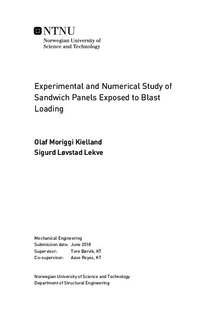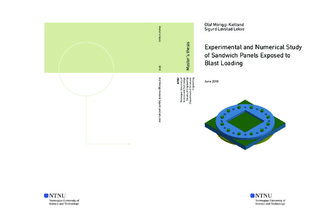| dc.contributor.advisor | Børvik, Tore | |
| dc.contributor.advisor | Reyes, Aase | |
| dc.contributor.author | Kielland, Olaf Moriggi | |
| dc.contributor.author | Lekve, Sigurd Løvstad | |
| dc.date.accessioned | 2019-09-11T08:35:23Z | |
| dc.date.created | 2018-06-08 | |
| dc.date.issued | 2018 | |
| dc.identifier | ntnudaim:19659 | |
| dc.identifier.uri | http://hdl.handle.net/11250/2614939 | |
| dc.description.abstract | The main objective of this thesis is to investigate, both experimentally and numerically, the mechanical response of various sandwich components with foam cores subjected to a range of blast load scenarios.
Experiments were performed in a shock tube facility at Structural Impact Laboratory (SIMLab), Norwegian University of Science and Technology (NTNU). Multiple sandwich configurations consisting of AA1050-H14 aluminum and DOCOL 600DL steel skins with a variation of XPS-foam cores were investigated. The components were exposed to nominal firing pressures in the range $10$ to $35~{bar}$. Three-dimensional digital image correlation (3D-DIC) was used to obtain deformation profiles and midpoint displacements of the back skins.
Experimental results indicate that foam core activation is increased using a low-density XPS-250 foam, compared to higher density XPS-foams. The use of a ROMER Absolute Arm in a scanning procedure post-experiment provided supplementary deformation data, which was included in a qualitative deformation analysis. Material tests were performed on the AA1050-H14 aluminum skins used in this study. Compression test data for the XPS-foams were taken from a previous study and was used for further investigation of the densification initiation strain and to introduce a density-dependent model.
A reference model was validated through a comparison of experimental and numerical results, which showed a slight overestimation of midpoint displacement by numerical simulations. However, general agreement in deformation history was found. A parametric study was conducted to identify trends in the structural behavior, concerning protective capabilities, by varying parameters such as foam density and core thickness. An optimal foam core configuration was found, regarding minimization of displacement and percent of energy absorbed in the back skin, while maximizing foam core activation. The optimal configuration was also found to vary with blast intensity. | en |
| dc.language | eng | |
| dc.publisher | NTNU | |
| dc.subject | Produktutvikling og produksjon, Industriell mekanikk | en |
| dc.title | Experimental and Numerical Study of Sandwich Panels Exposed to Blast Loading | en |
| dc.type | Master thesis | en |
| dc.source.pagenumber | 184 | |
| dc.contributor.department | Norges teknisk-naturvitenskapelige universitet, Fakultet for ingeniørvitenskap,Institutt for konstruksjonsteknikk | nb_NO |
| dc.date.embargoenddate | 2021-06-08 | |

